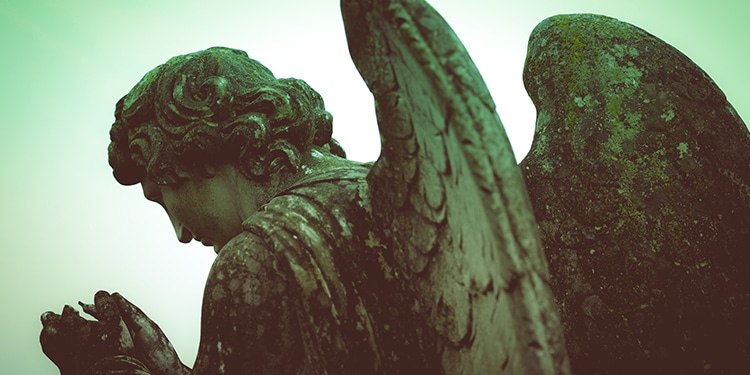The Book of Zechariah-Part 9
| By: Dr. Michael Stallard; ©2002 |
| Imagine a woman in a basket being carried by angels. What is it about such an unusual vision that would bring a message of hope to the nation of Israel? Dr. Stallard explains. |
The Book of Zechariah—Part 9
This article is the ninth in a series of articles designed to give a brief commentary on the prophetic portion of the Old Testament known as the book of Zechariah. In particular, this article will deal with the Vision of the Woman in the Ephah given in Zechariah 5:5-11. This vision is the seventh of eight night visions, which Zechariah receives (1:7-6:15). This particular vision can be distinguished from the previous vision in that its focus is not on individuals but on the nation of Israel as a whole. It is also true that this vision is different from the following vision. The next one deals with the future judgment upon the Gentile nations, while the Vision of the Flying Scroll centers on the removal of sin from the nation of Israel (although a hint of the future destruction of Babylon appears). The general gist of this vision then apparently focuses its message on the cleansing and forgiveness of God’s chosen people Israel.
The mentioned personages of the vision include Zechariah himself who receives the vision, the interpreting angel, a woman sitting in the ephah and the two women with wings. There is a change in scenery from the previous vision (the Flying Scroll) to this one as evidenced by the fact that the interpreting angel goes out from where they were to show Zechariah something (v. 5). While related to the previous vision (and to all the other visions), such wording marks this vision off with a specific boundary and focus.
The symbolism of the vision begins with Zechariah seeing an ephah, which is apparently flying around much like the flying scroll in the previous vision. The ephah is the most frequently mentioned dry measure in the Old Testament. The ancient equivalent liquid measure is the bath. The ephah was used to measure things such as flour, meal, and grain. The exact measurement does not appear to be clearly known and in fact may have been variable with interchangeable designations. Various sources place it between four and ten gallons in modern terms. Perhaps the most comparable image from the current day would be the bushel basket. In this vision the measurement of the ephah is described as a basket large enough to contain a woman. This is probably somewhat larger than that measure used normally in commercial dealings of the time. However, the meaning of the vision does not depend upon knowing the exact size of the ephah. The use of the measurement term adds to the idea that God is measuring something carefully.
The interpreting angel pronounces that the ephah is going forth (v. 5) and adds the general description that “this is their appearance in all the land.” This general description is given before Zechariah is shown the woman inside the ephah. The word appearance (NASB) has also been translated resemblance (KJV) and iniquity (NIV). Various ancient versions and manuscripts support the reading of eye or iniquity. Either one would fit the context. If the word iniquity is the correct reading, then the general description of the flying ephah gives the initial understanding of the negative meaning of the image. If the word eye were the accepted reading, Zechariah would not know about the issue of sin until seeing the woman called Wickedness in verses 7-8. The term eye yields the translation of appearance. The general sense of this reading is that what Zechariah sees (the ephah flying around) is what is seen throughout the land. The reading of iniquity might be preferred because of possible parallelism with the previous vision of the Flying Scroll. In that vision, the immediate description of the interpreting angel is the negative expression, “This is the curse…” (5:3). However, either reading yields the same interpretation for the vision as a whole. The word land could mean the entire world (planet earth), but most likely refers to the land of Israel in light of the context of the other night visions. So what Zechariah sees involves the nation of Israel as a whole.
Zechariah sees a woman in the basket after someone (probably the interpreting angel) lifts up the lead cover (v. 7). The lead lid on the ephah basket secures the woman inside and may emphasize the seriousness and certainty with which God is acting. In verse eight, the woman is personified as “Wickedness” as the text gives a picture of the interpreting angel throwing the woman into the ephah while crying out “This is Wickedness.” One should not read into the passage any harshness toward females in light of this designation since the Hebrew word for wickedness is in the feminine gender. In light of the earlier statement that the ephah was flying over all the land, one cannot escape the notion that God has bottled up, so to speak, all of the iniquity throughout the entire nation of Israel. Consequently, the woman represents all of the sinners in the land of Israel.
What will God do with this iniquity? In the next verse (5:9), Zechariah sees two women with wings who arrive apparently by means of flying (“coming out with the wind in their wings”). Their wings are described as the wings of a stork. The reference to the stork is natural in this text since the women are going to carry the ephah great distances and the stork has strong and large wings. These two women are not identified in the text. The two main interpretations identify them as either demonic forces or angelic messengers from God. The conclusion may hinge upon the action that they undertake in the text. They fly off carrying the ephah with the woman named Wickedness inside (v. 9). It is clear from the context that God is at work. However, God uses the fallen angels as well as the good angels (see Job 1-2). Nonetheless, the details favor the meaning of good angels, since it is more common to see them described as having wings (one possible exception is the demon horde in Revelation 9:9). If this is correct, it would mark the only passage in the Bible where good angels are described in appearance as women.
When do the women carry off the ephah? In light of the earlier Messianic implications in the night visions and the later prophecies in the book related to the Messiah’s coming, the timing of the carrying off of the ephah should be associated with the last days. It would be an encouragement for Zechariah’s post-exilic audience to know, that even though the nation of Israel had not yet received its full pardon and restoration, God was one day going to remove its sin, bottle it up, and send it off to another place. It would have been joyously startling to Zechariah’s original audience to know that the destination of its sin was Babylon from which it had recently been delivered. In verse ten, Zechariah asks the interpreting angel where the women with wings were taking the ephah. The next verse cites the land of Shinar, the geographical region where Babylon resides, as the final location. It is easy to associate this text with the idolatry of Babel in Genesis 11:1-9. The idolatry of Israel, which had culminated in its captivity in Babylon, was finally going to go home to roost and be dealt with there by God while Israel would enjoy its restoration. Most Christians would then associate this vision of Zechariah with Babylon’s destruction at the Second Coming of Jesus based upon Revelation 17-18. Whether the city is literal or figurative with respect to the last days does little to change the ultimate meaning of this vision. The prediction of removal of Israel’s sin (along with its ultimate restoration) would mean hope and happiness to Jews in Zechariah’s time that were still living in the times of the Gentiles.








